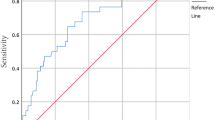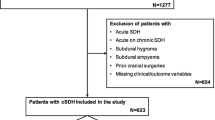Abstract
Background
Chronic subdural hematoma (CSDH) is a common illness in neurosurgical practice with a substantial recurrence rate. Previous studies found that serum lipids were associated with the risk of stroke and subarachnoid hemorrhage. In the current study, we aimed to identify the relationship between serum lipids and CSDH recurrence.
Methods
The medical records of 274 consecutive surgical patients with CSDH in our department were reviewed and analyzed. Patients were separated into recurrence and non-recurrence groups. Univariable and multivariable Cox proportional hazards regression analyses were performed to identify serum lipids (triglycerides, total cholesterol, LDL, HDL) and other potential predictors associated with CSDH recurrence, and the performance of predictors was assessed with receiver operating characteristic (ROC) curve.
Results
Of the 274 patients included in the study, 42 (15.3%) experienced at least 1 recurrence of CSDH. Univariate analysis showed that age, hypertension, diabetes mellitus, anticoagulant use, triglycerides, HDL, and midline shift were all significantly associated with CSDH recurrence. Multivariable Cox regression analysis found that only age, diabetes mellitus, midline shift, and HDL level were independent risk factors for CSDH recurrence. A higher HDL level (HR = 0.929, 95% CI 0.905–0.953) was significantly associated with a lower risk of recurrence, and ROC curve analysis revealed that the optimal HDL cut-off value as a predictor was 37.45 mg/dl.
Conclusions
Low level of high-density lipoprotein is significantly associated with recurrence of chronic subdural hematoma.


Similar content being viewed by others
Abbreviations
- AUC:
-
Area under the curve
- BMI:
-
Body mass index
- CI:
-
Confidence interval
- CSDH:
-
Chronic subdural hematoma
- CT:
-
Computed tomography
- GCS:
-
Glasgow Coma Scale
- HDL:
-
High-density lipoprotein
- HR:
-
Hazard ratio
- LDL:
-
Low-density lipoprotein
- MRI:
-
Magnetic resonance imaging
- ROC:
-
Receiver operating characteristic
- SAH:
-
Subarachnoid hemorrhage
References
Kolias AG, Chari A, Santarius T, Hutchinson PJ (2014) Chronic subdural haematoma: modern management and emerging therapies. Nature reviews. Neurology 10:570–578
Lind CR, Lind CJ, Mee EW (2003) Reduction in the number of repeated operations for the treatment of subacute and chronic subdural hematomas by placement of subdural drains. J Neurosurg 99:44–46
Gelabert-Gonzalez M, Iglesias-Pais M, Garcia-Allut A, Martinez-Rumbo R (2005) Chronic subdural haematoma: surgical treatment and outcome in 1000 cases. Clin Neurol Neurosurg 107:223–229
Motiei-Langroudi R, Stippler M, Shi S, Adeeb N, Gupta R, Griessenauer CJ, Papavassiliou E, Kasper EM, Arle J, Alterman RL, Ogilvy CS, Thomas AJ (2018) Factors predicting reoperation of chronic subdural hematoma following primary surgical evacuation. J Neurosurg 129:1143–1150
Rohde V, Graf G, Hassler W (2002) Complications of burr-hole craniostomy and closed-system drainage for chronic subdural hematomas: a retrospective analysis of 376 patients. Neurosurg Rev 25:89–94
Torihashi K, Sadamasa N, Yoshida K, Narumi O, Chin M, Yamagata S (2008) Independent predictors for recurrence of chronic subdural hematoma: a review of 343 consecutive surgical cases. Neurosurgery 63:1125–1129 discussion 1129
Wakai S, Hashimoto K, Watanabe N, Inoh S, Ochiai C, Nagai M (1990) Efficacy of closed-system drainage in treating chronic subdural hematoma: a prospective comparative study. Neurosurgery 26:771–773
Ro HW, Park SK, Jang DK, Yoon WS, Jang KS, Han YM (2016) Preoperative predictive factors for surgical and functional outcomes in chronic subdural hematoma. Acta Neurochir 158:135–139
Song DH, Kim YS, Chun HJ, Yi HJ, Bak KH, Ko Y, Oh SJ (2014) The predicting factors for recurrence of chronic subdural hematoma treated with burr hole and drainage. Korean J Neurotrauma 10:41–48
Stanisic M, Hald J, Rasmussen IA, Pripp AH, Ivanovic J, Kolstad F, Sundseth J, Zuchner M, Lindegaard KF (2013) Volume and densities of chronic subdural haematoma obtained from CT imaging as predictors of postoperative recurrence: a prospective study of 107 operated patients. Acta Neurochir 155:323–333 discussion 333
Stanisic M, Lund-Johansen M, Mahesparan R (2005) Treatment of chronic subdural hematoma by burr-hole craniostomy in adults: influence of some factors on postoperative recurrence. Acta Neurochir 147:1249–1256 discussion 1256-1247
You W, Zhu Y, Wang Y, Liu W, Wang H, Wen L, Yang X (2018) Prevalence of and risk factors for recurrence of chronic subdural hematoma. Acta Neurochir 160:893–899
Frati A, Salvati M, Mainiero F, Ippoliti F, Rocchi G, Raco A, Caroli E, Cantore G, Delfini R (2004) Inflammation markers and risk factors for recurrence in 35 patients with a posttraumatic chronic subdural hematoma: a prospective study. J Neurosurg 100:24–32
Hohenstein A, Erber R, Schilling L, Weigel R (2005) Increased mRNA expression of VEGF within the hematoma and imbalance of angiopoietin-1 and -2 mRNA within the neomembranes of chronic subdural hematoma. J Neurotrauma 22:518–528
Nagy JA, Vasile E, Feng D, Sundberg C, Brown LF, Manseau EJ, Dvorak AM, Dvorak HF (2002) VEGF-A induces angiogenesis, arteriogenesis, lymphangiogenesis, and vascular malformations. Cold Spring Harb Symp Quant Biol 67:227–237
Wang D, Jiang R, Liu L, Dong JF, Zhang JN (2010) Membrane neovascularization and drainage of subdural hematoma in a rat model. J Neurotrauma 27:1489–1498
Holl DC, Volovici V, Dirven CMF, Peul WC, van Kooten F, Jellema K, van der Gaag NA, Miah IP, Kho KH, den Hertog HM, Lingsma HF, Dammers R, Dutch chronic subdural hematoma research G (2018) Pathophysiology and nonsurgical treatment of chronic subdural hematoma: from past to present to future. World Neurosurg 116:402–411 e402
Caesar R, Tremaroli V, Kovatcheva-Datchary P, Cani PD, Backhed F (2015) Crosstalk between gut microbiota and dietary lipids aggravates WAT inflammation through TLR signaling. Cell Metab 22:658–668
Duewell P, Kono H, Rayner KJ, Sirois CM, Vladimer G, Bauernfeind FG, Abela GS, Franchi L, Nunez G, Schnurr M, Espevik T, Lien E, Fitzgerald KA, Rock KL, Moore KJ, Wright SD, Hornung V, Latz E (2010) NLRP3 inflammasomes are required for atherogenesis and activated by cholesterol crystals. Nature 464:1357–1361
Herbert KE, Erridge C (2018) Regulation of low-density lipoprotein cholesterol by intestinal inflammation and the acute phase response. Cardiovasc Res 114:226–232
Rubin EM, Krauss RM, Spangler EA, Verstuyft JG, Clift SM (1991) Inhibition of early atherogenesis in transgenic mice by human apolipoprotein AI. Nature 353:265–267
Tall AR, Yvan-Charvet L (2015) Cholesterol, inflammation and innate immunity. Nature reviews. Immunology 15:104–116
Zhang Q, Liu L, Zheng XY (2009) Protective roles of HDL, apoA-I and mimetic peptide on endothelial function: through endothelial cells and endothelial progenitor cells. Int J Cardiol 133:286–292
Jukema RA, Ahmed TAN, Tardif JC (2019) Does low-density lipoprotein cholesterol induce inflammation? If so, does it matter? Current insights and future perspectives for novel therapies. BMC Med 17:197
Gharavi NM, Gargalovic PS, Chang I, Araujo JA, Clark MJ, Szeto WL, Watson AD, Lusis AJ, Berliner JA (2007) High-density lipoprotein modulates oxidized phospholipid signaling in human endothelial cells from proinflammatory to anti-inflammatory. Arterioscler Thromb Vasc Biol 27:1346–1353
Can A, Castro VM, Dligach D, Finan S, Yu S, Gainer V, Shadick NA, Savova G, Murphy S, Cai T, Weiss ST, Du R (2018) Lipid-lowering agents and high HDL (high-density lipoprotein) are inversely associated with intracranial aneurysm rupture. Stroke 49:1148–1154
Gu X, Li Y, Chen S, Yang X, Liu F, Li Y, Li J, Cao J, Liu X, Chen J, Shen C, Yu L, Huang J, Lam TH, Fang X, He Y, Zhang X, Lu X, Wu S, Gu D (2019) Association of lipids with ischemic and hemorrhagic stroke: a prospective cohort study among 267 500 Chinese. Stroke 50:3376–3384
Huang Q, Shang-Guan HC, Wu SY, Yao PS, Sun Y, Zeng YL, Zheng SF, Chen GR, Lin YX, Kang DZ (2018) High-density lipoprotein is associated with progression of intracranial aneurysms. World Neurosurg 120:e234–e240
Iorio-Morin C, Touchette C, Levesque M, Effendi K, Fortin D, Mathieu D (2018) Chronic subdural hematoma: toward a new management paradigm for an increasingly complex population. J Neurotrauma 35:1882–1885
Toi H, Fujii Y, Iwama T, Kinouchi H, Nakase H, Nozaki K, Ohkuma H, Ohta H, Takeshima H, Tokumasu H, Yoshimoto Y, Uno M (2019) Determining if cerebrospinal fluid prevents recurrence of chronic subdural hematoma: a multi-center prospective randomized clinical trial. J Neurotrauma 36:559–564
Leppala JM, Virtamo J, Fogelholm R, Albanes D, Heinonen OP (1999) Different risk factors for different stroke subtypes: association of blood pressure, cholesterol, and antioxidants. Stroke 30:2535–2540
Sandvei MS, Lindekleiv H, Romundstad PR, Muller TB, Vatten LJ, Ingebrigtsen T, Njolstad I, Mathiesen EB, Vik A (2012) Risk factors for aneurysmal subarachnoid hemorrhage - BMI and serum lipids: 11-year follow-up of the HUNT and the Tromso Study in Norway. Acta Neurol Scand 125:382–388
Hua C, Zhao G, Feng Y, Yuan H, Song H, Bie L (2016) Role of matrix metalloproteinase-2, matrix metalloproteinase-9, and vascular endothelial growth factor in the development of chronic subdural hematoma. J Neurotrauma 33:65–70
Li T, Wang D, Tian Y, Yu H, Wang Y, Quan W, Cui W, Zhou L, Chen J, Jiang R, Zhang J (2014) Effects of atorvastatin on the inflammation regulation and elimination of subdural hematoma in rats. J Neurol Sci 341:88–96
Wang D, Li T, Wei H, Wang Y, Yang G, Tian Y, Zhao Z, Wang L, Yu S, Zhang Y, Chen J, Jiang R, Zhang JN (2016) Atorvastatin enhances angiogenesis to reduce subdural hematoma in a rat model. J Neurol Sci 362:91–99
Chon KH, Lee JM, Koh EJ, Choi HY (2012) Independent predictors for recurrence of chronic subdural hematoma. Acta Neurochir 154:1541–1548
Motoie R, Karashima S, Otsuji R, Ren N, Nagaoka S, Maeda K, Ikai Y, Uno J, Gi H (2018) Recurrence in 787 patients with chronic subdural hematoma: retrospective cohort investigation of associated factors including direct oral anticoagulant use. World Neurosurg 118:e87–e91
Pang CH, Lee SE, Kim CH, Kim JE, Kang HS, Park CK, Paek SH, Kim CH, Jahng TA, Kim JW, Kim YH, Kim DG, Chung CK, Jung HW, Yoo H (2015) Acute intracranial bleeding and recurrence after bur hole craniostomy for chronic subdural hematoma. J Neurosurg 123:65–74
Schwarz F, Loos F, Dunisch P, Sakr Y, Safatli DA, Kalff R, Ewald C (2015) Risk factors for reoperation after initial burr hole trephination in chronic subdural hematomas. Clin Neurol Neurosurg 138:66–71
Tokmak M, Iplikcioglu AC, Bek S, Gokduman CA, Erdal M (2007) The role of exudation in chronic subdural hematomas. J Neurosurg 107:290–295
Jiang R, Zhao S, Wang R, Feng H, Zhang J, Li X, Mao Y, Yuan X, Fei Z, Zhao Y, Yu X, Poon WS, Zhu X, Liu N, Kang D, Sun T, Jiao B, Liu X, Yu R, Zhang J, Gao G, Hao J, Su N, Yin G, Zhu X, Lu Y, Wei J, Hu J, Hu R, Li J, Wang D, Wei H, Tian Y, Lei P, Dong JF, Zhang J (2018) Safety and efficacy of atorvastatin for chronic subdural hematoma in Chinese patients: a randomized clinical trial. JAMA Neurol 75:1338–1346
Xu M, Chen P, Zhu X, Wang C, Shi X, Yu B (2016) Effects of atorvastatin on conservative and surgical treatments of chronic subdural hematoma in patients. World Neurosurg 91:23–28
Funding
The present study was supported by grants from the Natural Science Foundation of Zhejiang Province, China (LQ20H090008) and Medical Scientific Research Foundation of Zhejiang Province, China (2020RC010). The sponsor had no role in the design or conduct of this research.
Author information
Authors and Affiliations
Corresponding author
Ethics declarations
Conflict of interest
The authors declare that they have no conflict of interest.
Ethical approval
All procedures performed in studies involving human participants were in accordance with the ethical standards of the institutional and/or national research committee and with the 1964 Helsinki declaration and its later amendments or comparable ethical standards. For this type of study formal consent is not required.
Informed consent
Informed consent was obtained from all individual participants included in the study.
Additional information
Publisher’s note
Springer Nature remains neutral with regard to jurisdictional claims in published maps and institutional affiliations.
This article is part of the Topical Collection on Brain trauma
Rights and permissions
About this article
Cite this article
Liu, WC., Lin, QQ., Jin, J. et al. An association of low high-density lipoprotein levels with recurrence of chronic subdural hematoma. Acta Neurochir 163, 1061–1068 (2021). https://doi.org/10.1007/s00701-020-04638-6
Received:
Accepted:
Published:
Issue Date:
DOI: https://doi.org/10.1007/s00701-020-04638-6




